Bulletin – March 2019 Australian Economy Firm-level Insights into Skills Shortages and Wages Growth
- Download 526KB

Abstract
Despite increased reports of skills shortages from contacts in the RBA's regional and industry liaison program since 2016, national wages growth has picked up only a little and remains subdued. Information collected through the liaison program since the early 2000s suggests Australian firms use a range of practices in addition to, and sometimes before, increasing wages to address skills shortages. In the short run, this may constrain the effect of skills shortages on wages growth.
Introduction
The emergence of skills shortages has been a central theme in the Bank's meetings with firms as part of the regional and industry liaison program over the past couple of years. Australian firms have increasingly reported pockets of skills shortages, especially in information technology (IT), construction and engineering occupations since 2016. A key question is whether and when these reports of skills shortages will translate to higher wages growth, which economic theory suggests should happen when demand for labour exceeds supply. To investigate the relationship between skills shortages and wages growth, this article summarises historical liaison information about the evolution of skills shortages, how firms reported responding to shortages, and the effect of shortages on wages. The recent period is compared with the period of increasing wages growth between 2002 and 2007. Further insights are drawn from Australian research on skills shortages and firm decision-making, as well as published information about liaison programs and skills shortages in the United States and the United Kingdom.
There are a number of definitions of skills shortages. Where practical, this work defines skills shortages as occurring when demand exceeds supply of appropriately skilled workers available at a prevailing market wage (Healy, Mavromaras and Sloane 2015). It is not a skills shortage when an employer is not willing or able to pay the market wage. For example, some not-for-profit organisations have discussed labour availability concerns during liaison meetings, but also commonly acknowledge that they typically pay below the usual market wage, so have been excluded from this analysis. Unfortunately, we cannot know if shortages reported by other liaison contacts follow this definition, and this may also affect any survey data of skills shortages.
Insights from Liaison with Firms
Since the regional and industry liaison program began in 2001, there has only been one prolonged period of broad labour market tightness, which occurred in the years leading up to the 2008 financial crisis. This section draws insights from the Bank's liaison information through this time to identify the various experiences of firms and the strategies firms used to address skills shortages.[1]
Labour market tightness during 2002–07
Starting in 2002–03, shortages were commonly reported in the residential part of the construction industry. While there were some mentions of skills shortages in the non-residential part of the construction industry, as well as in manufacturing, mining, health and some business services industries, they were less pronounced and/or not as widespread across Australia.[2] Wages growth, as measured by the wage price index (WPI), started to pick up in late 2002 (Graph 1). The WPI measures the changes in wage and salary rates (total hourly rates of pay) for a given quantity and quality of labour for a fixed basket of jobs and is published both excluding and including bonuses.[3] The index excludes changes in wages caused by changes in the nature of work performed and changes to labour force composition; the WPI excluding bonuses also excludes the effect of changes in the quality of the work performed. The national accounts measure of average earnings per hour (AENA) is a broader labour cost measure which includes non-wage costs (for example, superannuation, travel allowances and redundancy payments) and is affected by compositional changes in employment. This can make it difficult to determine the drivers of AENA fluctuations.
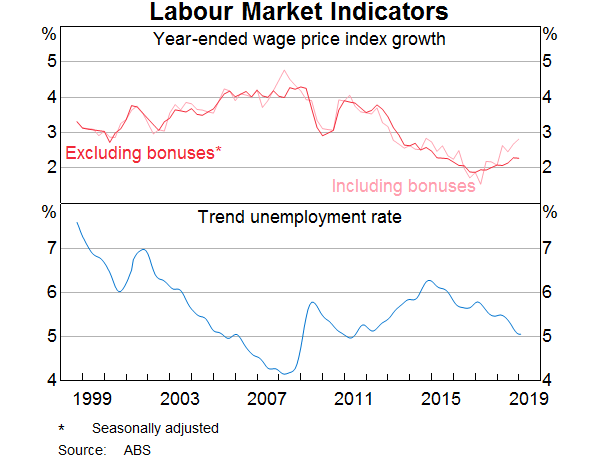
Reports of skills shortages were increasing and more widespread in 2004. These reports broadened to include service sector firms (such as tourism-related and equipment-hire firms) and teachers, and intensified in construction and some business services industries. Wage pressures were building in response to the tightening labour market. The use of non-wage remuneration to attract and retain labour was increasingly reported in the second half of 2004, such as the use of training to upskill workers. Increased bonus payments, which increase temporary payments to employees but avoid permanently increasing wage levels, were also more frequently reported.
In 2005, reports of skills shortages were widespread and persistent across a broad range of industries and skill sets. These reports were accompanied by accounts of increasing wage pressures and the WPI measure of wages growth increased to a little over 4 per cent during the year. Wages growth including bonuses was also strong in 2005, reflecting firms' more frequent use of bonuses to attract and retain labour.
The use of non-wage remuneration also broadened over the year and included executive-style packages, increased leave provisions, earlier promotion opportunities, increased use of overtime payments, the provision of more attractive workplaces, and more frequent salary reviews.
Firms continued to report acute and pervasive skills shortages in 2006. These shortages affected highly skilled, semi-skilled and low-skilled positions (as more low-skilled workers were attracted to mining), and were severe in mining, non-residential construction and business services, although shortages eased in residential construction. Skills shortages were reported to be constraining employment growth and output, and some firms were leaving positions unfilled or increasing their use of short-term contractors, overseas workers and recruitment agencies to fill roles. The use of non-wage remuneration to address skills shortages continued to be reported by many firms.
Growth in the WPI was broadly stable during 2006, despite increased labour turnover and reports of poaching (that is, higher wage levels being used to entice workers to switch jobs). Liaison information indicated that growth varied significantly between industries, and those with the most acute shortages like construction, mining, utilities and business services saw higher wages growth (Graph 2). Industries such as retail trade and manufacturing did not report much wage pressure; more subdued wages growth in these industries helped to stabilise overall wages growth.
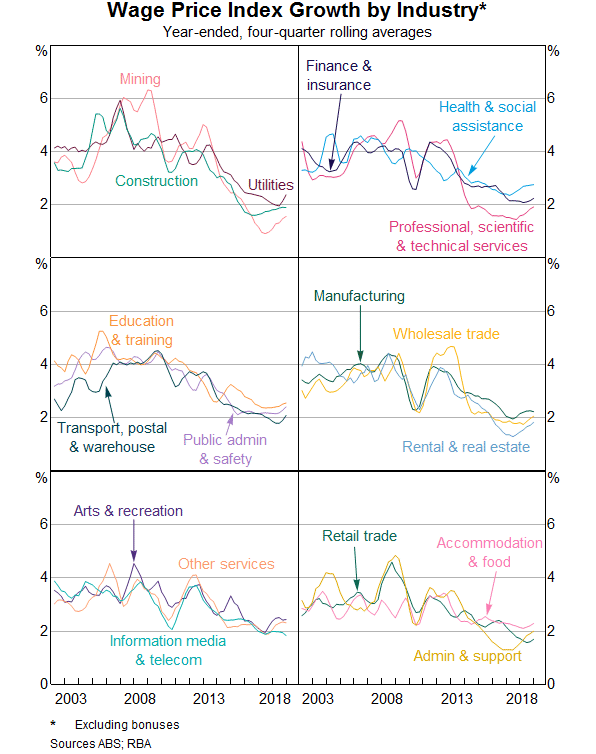
Reports of broad-based skills shortages intensified in 2007. Mining, non-residential construction and business services remained the most affected, though reports of shortages in other industries also increased. Shortages were reported in all states, but resource-rich states were the most affected, especially by shortages of low-skilled labour. There were continued reports during 2007 that shortages were constraining output growth, and higher staff turnover had led to increased absenteeism, reduced motivation and more overtime work for others.
WPI growth excluding bonuses remained firm but stable despite liaison reports of wage pressures. Wages growth continued to vary by industry, skills and states, and was strongest where the most severe shortages were found. However, there was still little evidence of wage pressures in industries such as retail trade and manufacturing, and in hospitality-related roles.
Firms responded to skills shortages in 2007 in a broad range of ways, many of which avoided additional payments directly to staff or included higher temporary payments. By the end of 2007, wages growth including bonuses was noticeably higher than wages growth excluding bonuses. This is likely to have partly reflected firms' efforts to constrain labour costs in the longer term; AENA growth also increased in 2007. Strategies firms reported taking to address skills shortages fall broadly into three categories (albeit, with some overlap): strategies aimed at increasing a firm's labour supply; strategies which constrained a firm's labour growth or increased productivity; and strategies which increased labour costs to retain staff (Table 1). In terms of wage strategies, some firms offered targeted wage increases to high-performing staff, and a few shortened salary review periods. A small number were paying higher wages to all staff, but with the caveat that this was not sustainable.
| Increasing labour supply | Constraining labour growth, or increasing productivity | Increasing labour costs to retain staff |
|---|---|---|
|
|
|
|
Source: RBA |
||
In summary, during the only period of acute labour market tightness for which we have liaison information, increasing wages was only one method of trying to attract and retain staff, and was commonly not the first or favoured response. Firms actively tried to constrain wages growth by using a raft of non-wage measures to address skills shortages. Because only some of these measures involved payments directly to staff, this lowered the direct effect of skills shortages on wages growth.
The recent experience
By comparison, reports of skills shortages from liaison between 2016 and 2018 have occurred in the context of a labour market which still has some spare capacity. Shortages have been reported mostly in IT, and in construction and engineering; this is consistent with the high volume of residential and non-residential construction activity and public infrastructure work being undertaken on the east coast during this time. Liaison has reported pockets of higher wages growth for construction, engineering and IT roles but, at the industry level, the overall pattern of constrained wages growth has been quite uniform. Recorded wages growth does not appear to have differed by much across industries over the past year (Graph 3).[4]
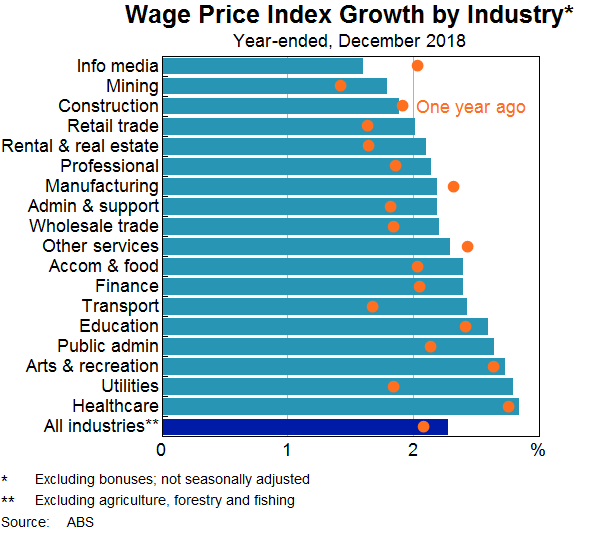
Consistent with the liaison evidence from the pre-2008 period, firms facing skills shortages over the past two years have reported responding by means other than increasing wages such as hiring less-skilled workers and increasing training for existing staff. The use of targeted bonuses has also increasingly been reported by liaison contacts, which is consistent with the increase in wages growth seen in the WPI measure that includes bonuses.
Box A: Insights from Job-level Data
Job-level WPI data can provide further insights on the link between skills shortages and wages growth. Together, the Reserve Bank and the Australian Bureau of Statistics (ABS) have looked at the wage increases for all the 18,000 individual jobs that the ABS uses to construct the WPI. These data are useful for examining whether there are pockets of higher wages growth in the labour market.
This job-level analysis provides little evidence that skills shortages have translated into pockets of higher base wages growth in recent years. However, there is some evidence of pockets of higher wages growth if we consider a broader measure of hourly compensation that includes bonuses, in addition to base wages.[5] To see this, we aggregate the job-level WPI data to the 3-digit occupation level. There are around 90 such occupation classifications, which include roles like ‘systems analysts & programmers’, ‘database administrators and IT security specialists’ and ‘engineering professionals’. If there are pockets of higher wages growth in the labour market, we would expect to see at least a few of these occupations having large wage rises. For base wages, this does not appear to be the case. The top panel of Graph A1 shows the distribution of annual base wages growth across occupations; the height of each bar represents the share of occupations with an annual wage increase of a given amount, averaged over the 2016 to 2018 period. This shows that the distribution in wages growth across occupations has been highly compressed, with no occupation having wages rises in excess of 4½ per cent over the period considered. However, after including bonuses, there are a handful of occupations with relatively strong growth in hourly compensation (bottom panel of Graph A1).
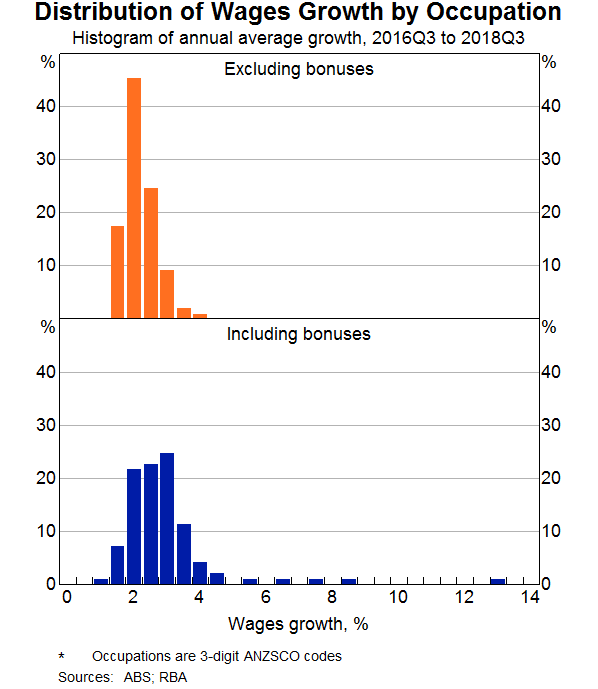
We can also look for evidence of pockets of higher wages growth in the distribution of wage increases across the 18,000 individual jobs in the WPI sample (rather than the 90 occupation categories considered above). To do this, we simply take the year-ended wage change for every job in the WPI sample, and then calculate the percentiles of that distribution at each point in time. Again, if we exclude bonuses, we observe little evidence of pockets of higher wages growth (LHS panel of Graph A2). Even the 99th percentile of the wages growth distribution is at low levels compared to historical standards, and currently at its lowest level in the history of the WPI. This contrasts with the earlier period of reported skills shortages in 2007, where a much larger share of jobs was experiencing large pay rises. If we include bonuses, there is a bit more evidence of higher wages growth outcomes at the top of the distribution; however, this strength is only evident above the 97th percentile (RHS panel of Graph A2), which means that, if there are pockets of strength in the economy, they are confined to a very small fraction of jobs.
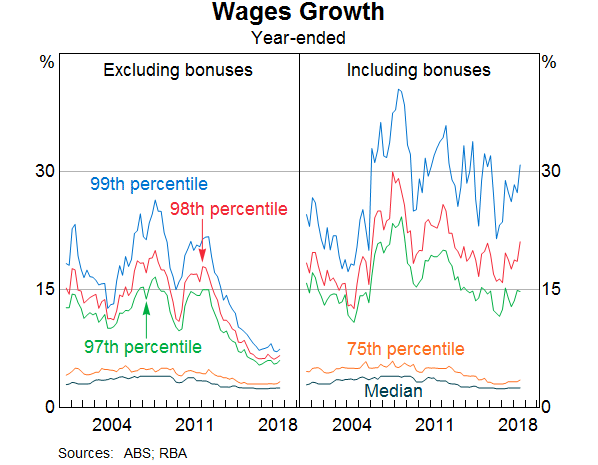
Do Liaison Conclusions Differ from Other Australian Research and Data?
We can conclude from liaison information that increasing wages is one of many methods used by firms to address skills shortages. Firms actively try to constrain wages growth by using a variety of non-wage financial and non-financial measures when faced with skills shortages, which is likely to weaken the direct effect of shortages on wages growth.
There is not much in the literature to suggest why and when Australian firms should take certain actions to respond to labour market tightness, and very little on the actions they do take. Healy, Mavromaras and Sloane (2015) used the ABS's Business Longitudinal Database (BLD, now supplanted by the Business Longitudinal Analysis Data Environment, or BLADE) to examine: the determinants of different types of skills shortages faced by Australian small- and medium-sized enterprises; the response strategies firms use to address skills shortages; and the short-term consequences of skills shortages for firm performance from 2004 to 2007. The authors found that firms facing more complex skills shortages (where two, or three or more options were selected as the cause of the shortage) were more likely to increase the hours of their existing workforces and/or increase wages or conditions than firms facing simple shortages (with only one cause selected). However, in a weighted sample of firms that faced skills shortages in 2004–05, only 16 per cent responded by increasing wages or conditions. More common responses were to increase the hours of the firm's existing workforce, subcontract or outsource work, provide on-the-job or internal training and reduce outputs or production.
The NAB Quarterly Business Survey asks around 900 firms how different factors constrain output, including the availability of suitable labour. Respondents can answer that labour supply is a significant constraint, a minor constraint or no constraint (or not applicable). The survey has suggested that suitable labour has become significantly harder to find over the past two years or so, and has been around 2006 levels since late 2017. Results for NAB's ‘labour is a constraint’ question have also diverged from the historical relationship with WPI (Graph 4). It is likely part of the explanation that while the share of those saying labour is a major constraint on output has increased noticeably over the last few surveys, this group is still smaller than it was from mid-2005 to 2008 (Graph 5).
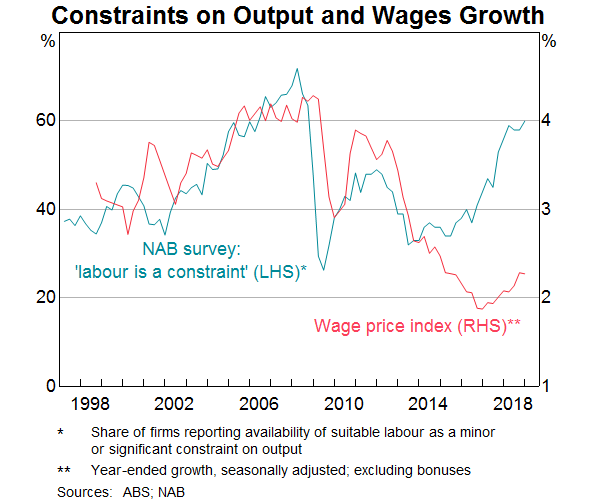
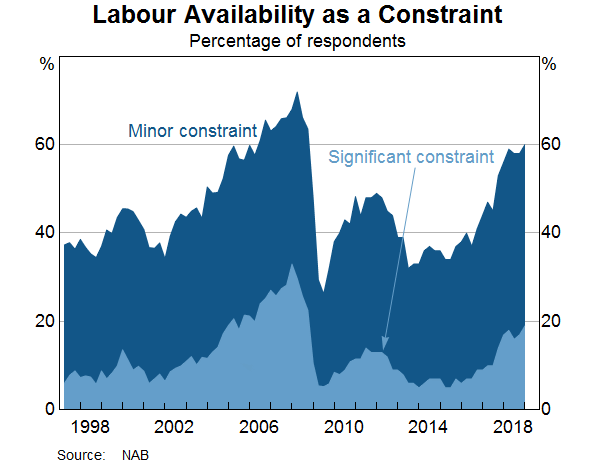
The Australian Government Department of Jobs and Small Business conducts research each year to determine state and national skills shortages (including shortages particular to specialisations within occupations). This can provide an insight into how widespread skills shortages are over time.[6] The number of occupations experiencing national shortages rose rapidly in the years before the financial crisis and fell rapidly after (Graph 6). Similar to the NAB survey, it has increased a bit in the last few years, suggesting that skills shortages have broadened, but it remains well below pre-financial crisis levels.
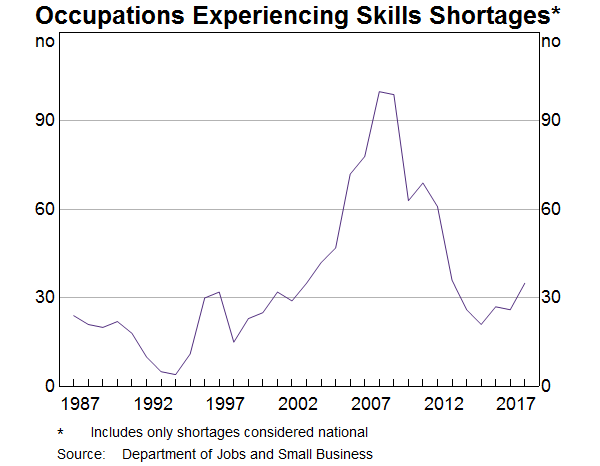
Does the Australian Experience Differ from Other Countries' Experiences?
A comprehensive review of overseas liaison evidence is beyond the scope of this article but some insights can be drawn from other markets. It is commonly observed that wages growth was subdued in the United States (US) and United Kingdom (UK) in recent years, despite falling unemployment and increasing reports of skills shortages, although wages growth did pick up in both countries in 2018 (Graph 7).[7]
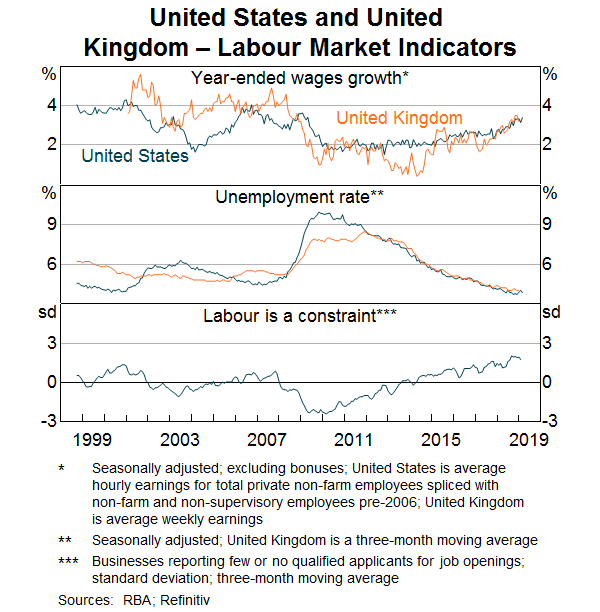
The Federal Reserve's Beige Book has continued to report that labour markets in the United States are ‘tight’, and skills shortages were increasingly mentioned from 2016 (and there were reports of pockets of skills shortages and tightening labour markets before then):
Labor markets across the country remained tight, restraining job gains in some regions. Contacts continued to note difficulty finding qualified candidates across a broad array of industries and skill levels. Reports of labor shortages over the reporting period were most often cited in high-skill positions, including engineering, information technology, and health care, as well as in construction and transportation. (Federal Reserve District 2018).
As in Australia, firms were also reported to have used non-wage strategies, such as increasing training and automation, as well as increasing wages to address skills shortages (Federal Reserve District 2018). While wages growth did pick up in 2018, it had been weak over the previous few years despite increased reports of skills shortages. Periods of labour market tightness and stable wages growth have been reported in the Federal Reserve's Beige Book numerous times and at least as far back as 1995.
To explain why wages growth remained low despite widespread reports of skills shortages, some have suggested that American firms are more cautious and unwilling to offer permanent wage increases to address skills shortages because of their experiences during the financial crisis. It may also have been that workers are less willing and able to bargain for higher wages after the financial crisis, partly due to declining union membership and collective bargaining, and increased market power of firms to employ workers such as through non-compete clauses and no-poaching agreements (Krueger 2018). Krugman (2018) also hypothesised that US reports of skills shortages were so widespread because human resource managers had forgotten what full employment looks like, and reported shortages when fewer highly qualified workers applied for each job than in previous years.
The United Kingdom has also experienced skills shortages, partly due to the fall in net migration from the European Union following the Brexit vote. The Bank of England's liaison program has found that recruitment difficulties have increased over the past couple of years. Further, skills shortages were said to be constraining headcount growth, particularly in industries with the most acute skills shortages such as construction, haulage and IT (Bank of England 2018).
Wages growth had been subdued for a number of years before increasing a bit in 2018. Recent increases in wages growth were attributed to a number of factors, including staff retention:
Average pay settlements were a little higher than a year ago, in a range of 2½%–3½%. Growth in total labour costs picked up due to the increase in employers' pension auto-enrolment contributions; the rise in the National Living Wage – and pressure to maintain pay differentials in line with it; the Apprenticeship Levy, and ad hoc payments to retain staff with key skills. (Bank of England 2018).
Firms also reported using numerous strategies to address skills shortages, as in Australia and the United States, such as improved working conditions, employing more lower-skilled workers and increasing automation (Bank of England 2018).
The long periods of subdued wages growth, despite increasing reports of skills shortages, is similar to the current Australian experience. High levels of spare capacity in the preceding years may have skewed views on skills shortages in each economy and may explain some of the gap between reported shortages and wages growth. However, there are differences between each country's labour markets. Non-compete restrictions and other anti-competitive practices are unlikely to have affected wages growth in Australia as much as in the United States. Both the US and UK labour markets began tightening a few years before Australia's, and unemployment in both countries are below OECD estimates of their natural rates of unemployment. Reports of skills shortages also appear more frequent, and shortages more widespread, than in Australia.
Conclusion
Overall liaison information supports the conclusions of the RBA's forecasts that, while wages growth is likely to continue picking up over the next few years, increases are expected to be gradual. Increasing wages is one of many strategies firms use to address skills shortages and is, at times, only chosen after a range of other responses. This may dampen the short-run effect of skills shortages on wages growth. However, because this pattern of choices was also common prior to the 2008 financial crisis, it does not fully explain the recent weakness in wages growth.
Footnotes
The author is from Economic Analysis Department and would like to thank James Bishop (from Economic Research Department) for his contribution on job-level data in Box A. [*]
Labour availability may not be discussed in all liaisons. See RBA (2014) for more information about the liaison program. [1]
There is not one definition of ‘business services’ and the industries it covers (Manalo and Orsmond 2013). However, the RBA tends to classify firms in the following industries as ‘business services’: professional, scientific & technical services; administrative & support services; rental, hiring & real estate services; information media & telecommunications; and financial & insurance services. [2]
All wage measures considered in this article capture changes in both ordinary time hourly wage and salary rates, and overtime hourly rates. The WPI excludes changes in penalty payments (such as for overtime, weekends and public holidays) because these payments vary based on hours worked at penalty rates. The WPI is also not affected by changes in allowances which fluctuate (for example, allowances paid according to how much work is performed in heat or at height). [3]
For more information on low wages growth in Australia, please see Bishop and Cassidy (2017). [4]
The data on wage measures that include bonuses can reflect changes in the quality of the work performed and should be interpreted with caution, particularly at the level of granularity shown in Graph A1 and Graph A2. [5]
There are caveats to historical comparisons of these data. Only selected skilled occupations are included, and the occupation coverage has changed over time. Lack of a rating in any year doesn't necessarily mean there was no shortage for that occupation; it may mean the occupation was not assessed. Occupations are grouped by ANZSCO code. [6]
Arsov and Evans (2018) find that lower productivity growth, the difficulty cutting wages after the financial crisis and decreased labour bargaining power have contributed to (but do not fully explain) low wages growth in advanced economies, including the United States and the United Kingdom. [7]
References
Arsov I and R Evans (2018), ‘Wage Growth in Advanced Economies’, RBA Bulletin, March.
Bank of England (2018), ‘Agents’ summary of business conditions and results from the Decision Maker Panel survey', 13 September. Available at <https://www.bankofengland.co.uk/-/media/boe/files/agents-summary/2018/2018-q3.pdf?la=en&hash=E4CE9EA96564272555C39A2435628129036FB52A>.
Bishop J and N Cassidy (2017), ‘Insights into Low Wage Growth in Australia’, RBA Bulletin, March, pp 13–20.
Federal Reserve District (2018), ‘The Beige Book: Summary of Commentary on Current Economic Conditions’, 18 April. Available at <https://www.federalreserve.gov/monetarypolicy/files/BeigeBook_20180418.pdf>.
Healy J, K Mavromaras and PJ Sloane (2015), ‘Adjusting to skill shortages in Australian SMEs’, Applied Economics, 47(24), pp 2470–2487.
Krueger AB (2018), ‘Reflections on Dwindling Worker Bargaining Power and Monetary Policy’, Luncheon Address at the Jackson Hole Economic Symposium, Jackson Hole, 24 August. Available at <https://www.kansascityfed.org/~/media/files/publicat/sympos/2018/papersandhandouts/kc%20fed%20lunch%20remarks%20-%20as%20prepared%20for%20delivery%20v2.pdf?la=en>.
Krugman P (2018), ‘Monopsony, Rigidity, and the Wage Puzzle (Wonkish)’, The New York Times, 20 May. Available at <https://www.nytimes.com/2018/05/20/opinion/monopsony-rigidity-and-the-wage-puzzle-wonkish.html>.
Manalo J and D Orsmond (2013), ‘The Business Services Sector’, RBA Bulletin, March, pp 1–10.
RBA (Reserve Bank of Australia) (2014), ‘The RBA's Business Liaison Program’, Bulletin, September, pp 1–5.